Effective Strategies for Killing Grass and Weeds in Flower Beds


Intro
Maintaining flower beds can become a challenging task for gardeners. The presence of grass and weeds can compromise the vitality of the flowers, making them less visually appealing. This article aims to provide actionable strategies for effectively eliminating unwanted vegetation. Understanding how to manage these problems not only maintains an attractive garden but also supports plant health.
In the following sections, we will examine different methods of removal. Strategies such as manual removal, chemical treatments, and natural approaches will be discussed. Each method has its benefits and drawbacks, thus it's important to consider each one carefully. Moreover, we will address preventative measures that can help minimize future weed growth.
By the end of this article, readers will have a robust toolkit for tackling grass and weeds in their flower beds, enriching their gardening experience.
Understanding the Challenge
Gardening is often thought of as a peaceful and rewarding hobby. However, the reality includes various challenges, particularly when it comes to caring for flower beds. Understanding the challenges posed by grass and weeds can significantly impact how one approaches garden maintenance. It is crucial for homeowners and gardening enthusiasts to grasp why these undesired plants thrive in their flower beds.
Weeds and unwanted grass not only disturb the aesthetics of a flower bed, but they also compete for vital resources such as nutrients, water, and sunlight. Weeds can grow rapidly and can even outsize flower plants, hindering their growth and potentially leading to their decline. The importance of managing these invasive plants cannot be understated.
Timely intervention can greatly enhance the health of desired plants. Neglecting weeds allows them to propagate, creating a more challenging environment and an escalating workload in the future. Monitoring flower beds regularly means one can take early action against emerging weeds. This proactive approach is essential for maintaining vibrant and healthy flora.
"A proactive approach in weed management ensures that plants receive the resources they need to thrive."
In addition, eliminating grass from flower beds presents its own set of challenges. Grass and flowers often have similar light and water needs. Managing these conditions requires careful planning and execution. Homeowners must be aware of the specific needs of their flowers while also being vigilant about grass that encroaches on their space. This layer of complexity makes understanding the challenge of weeds and grasses essential for effective garden management.
Overall, recognizing the issues that weeds and grass present creates a foundation for implementing effective strategies for their removal. With a strong understanding of these challenges, gardeners can move forward with confidence."
Identifying Grass and Weeds
When it comes to maintaining flower beds, understanding the significance of identifying grass and weeds cannot be overstated. Proper identification allows gardeners to develop competitive strategies against unwanted vegetation. This focus ensures that the desired plants thrive and contribute to the overall visual appeal of the garden. Knowledge of specific characteristics helps to tailor the approach to removal and prevention, ultimately enhancing the health of your flower bed.
Characteristics of Common Weeds
Recognizing the physical traits of common weeds is crucial for effective control. Some prevalent weeds found in flower beds include:
- Dandelion: Features a rosette of deeply lobed leaves and a prominent yellow flower that turns into a puffball.
- Creeping Charlie: Has round, scalloped leaves and spreads through runners, creating a dense mat.
- Crabgrass: Grows low to the ground, with upright stems and long, thin leaves that are easily mistaken for grass.
These weeds often have distinct growth patterns and reproductive strategies. For example, dandelions produce thousands of seeds that are dispersed by the wind, leading to rapid population expansion. By familiarizing oneself with these traits, gardeners can act promptly before weeds become entrenched.
Distinguishing Between Grass and Desired Plants
Distinguishing between grass and desirable plants in flower beds can often be challenging. Here are some essential considerations to help clarify this distinction:
- Leaf shape and texture: Many grasses may mimic the foliage of certain flowers but often have a narrower shape. Flowering plants may provide a variety of textures which grasses do not.
- Growth pattern: Grasses typically grow in clumps or have a more uniform look, while flower plants may have varied heights and branching structures.
- Flower presence: Most desired plants will eventually produce flowers, while grass generally will not.
"Understanding the differences in appearance allows for timely removal of unwanted grass before it becomes established in the flower bed."
A closer examination of the surrounding plant life will yield vital information. Using tools like garden guides or apps can aid in identifying plants accurately. The early identification is invaluable as it helps to formulate a more comprehensive weed management plan.
By emphasizing the importance of identification, gardeners arm themselves with necessary knowledge to protect their cherished flower beds from the encroachment of grass and weeds.
Manual Removal Techniques
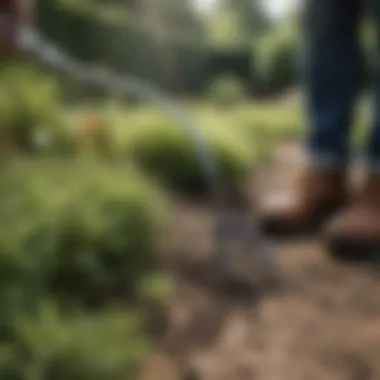
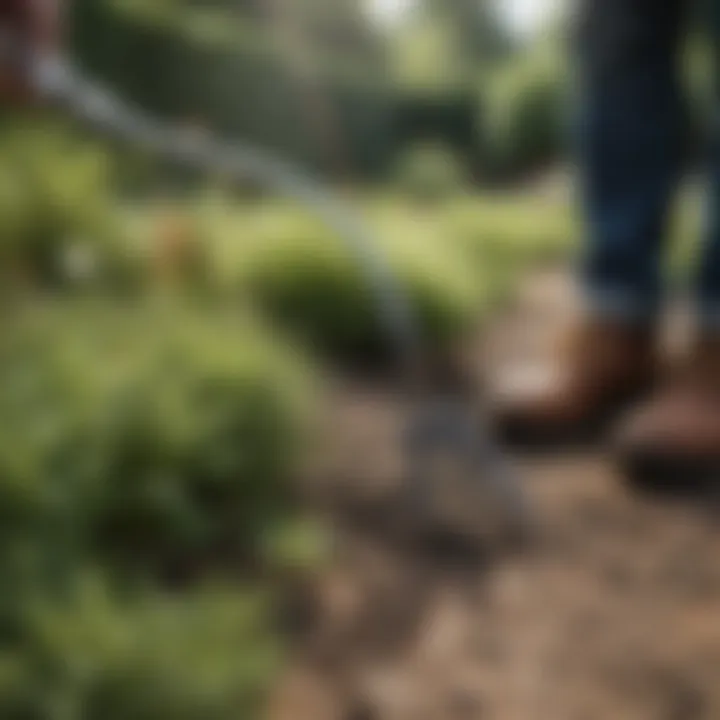
Manual removal techniques play a crucial role in the comprehensive strategy for controlling grass and weeds in flower beds. Unlike chemical methods that can pose risks to the environment and non-target plants, manual methods offer a targeted approach. These techniques empower gardeners to physically remove unwanted plants, minimizing the risk of herbicide resistance and disturbances in the local ecosystem. Manual removal also allows for the preservation of the flower bed's health, as it reduces competition for nutrients and water. Nevertheless, these methods require diligence and effort, making it vital for homeowners to adopt efficient practices.
Hand Pulling Weeds
Hand pulling is perhaps the simplest way to control weeds. This technique involves grasping the base of the weed, then pulling upwards firmly to dislodge the entire root system from the soil. It is important to pull weeds when the soil is moist, as it makes this task easier and ensures the complete removal of the root.
To be successful with hand pulling, you must be able to identify the weeds properly. Some common types include dandelions, clover, and chickweed, each with distinct roots and growth habits. Pay close attention to perennial weeds, as they often regrow quickly if part of the root remains in the soil.
Using Garden Tools
For larger weed infestations, garden tools can aid in the efficient removal process. Tools such as hoes, trowels, and weeders are valuable in managing tougher weeds with deeper roots. Utilizing a weeder, for instance, allows for reaching into the soil to extract stubborn roots without disturbing surrounding plants too much.
A hoe can also facilitate quick weeding, particularly when used for surface weeds. By scraping the blade just beneath the soil surface, you can cut off undesirable plants at ground level. However, remember to use these tools carefully to avoid damaging your flower bed's plants.
Best Practices for Manual Removal
To maximize the effectiveness of manual removal techniques, consider the following best practices:
- Timing: Weeding after rainfall or watering helps ease the task significantly. Weeds are easier to pull when the ground is not compacted.
- Regular Maintenance: Preventing weeds from establishing is more efficient than dealing with established plants. Aim to inspect your flower beds regularly.
- Dispose of Weeds Properly: Once removed, dispose of weeds in a manner that prevents them from reestablishing. Composting may not be ideal for certain highly invasive species.
- Wear Protective Gear: Gloves can protect your hands from thorns or irritation. Appropriate footwear will also keep you comfortable while working in the garden.
In summary, manual removal techniques offer a straightforward method for controlling grass and weeds in flower beds. With an understanding of when and how to pull weeds effectively, as well as the right tools, homeowners can maintain their flower beds with less reliance on chemical treatments.
Chemical Solutions
Chemical solutions offer a direct approach for effectively managing grass and weeds in flower beds. They serve as an option for gardeners who seek immediate results when manual removal or natural methods may not suffice. However, understanding the landscape of chemical interventions is crucial. Benefits such as the reduction of labor intensity and quicker results are appealing. Yet, considerations around safety and environmental impacts must not be overlooked.
Weeds and unwanted grasses often compete aggressively for nutrients, water, and sunlight. Chemical solutions can target these intruders while leaving desirable plants largely unharmed. When applied correctly, herbicides can assist in maintaining an aesthetically pleasing garden without extensive labor. Nevertheless, misuse can lead to adverse effects on both plants and the ecosystem, highlighting the need for responsible application.
By delving deeper into specific types of herbicides, application safety, and awareness of chemical resistance, gardeners can make informed decisions that lead to healthier flower beds and a thriving garden space.
Types of Herbicides
Herbicides can be categorized into two main groups: pre-emergent and post-emergent.
- Pre-emergent Herbicides
- Post-emergent Herbicides
- These target weed seeds before they sprout.
- They create a barrier that prevents germination, making them useful for preventing weeds before they become established.
- Common choices include prodiamine and pendimethalin.
- These are applied after the weeds have emerged.
- They penetrate the leaves and disrupt the growth processes in established weeds.
- Popular options include glyphosate and 2,4-D.
When selecting herbicides, it’s essential to consider the types of weeds being targeted and the specific plants in the flower bed. Mixing these two types can also enhance effectiveness if applied at the correct times, but always ensuring compatibility with your desired plants is necessary for success.
Safe Application of Chemicals
Applying chemicals requires care and precision. To ensure safety in application, follow these guidelines:
- Read Labels Carefully: Always follow the manufacturer's instructions on dosage and methods of application.
- Wear Protective Gear: Use gloves, goggles, and protective clothing to prevent skin contact and inhalation of chemical fumes.
- Choose Optimal Conditions: Apply chemicals on dry, calm days to prevent drift onto nearby plants.
- Consider Timing: Early morning or late afternoon is often best to avoid high temperatures and intense sunlight that can affect efficacy.
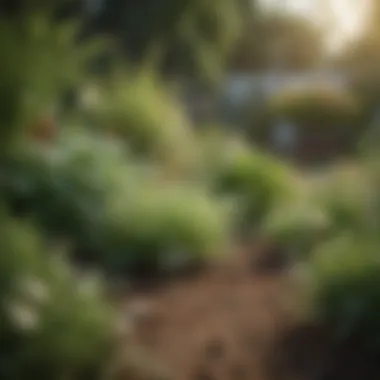
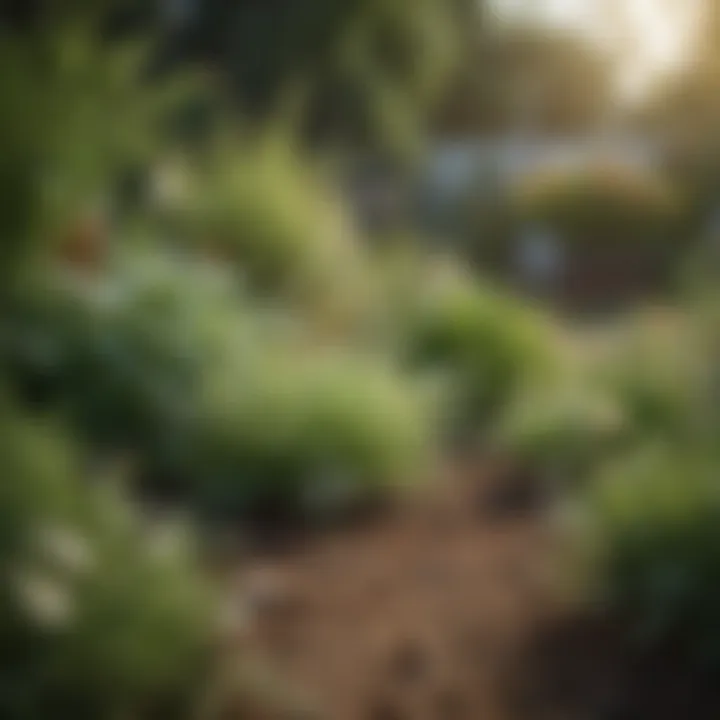
By adhering to these safety measures, gardeners can minimize risks to themselves, desirable plants, and the surrounding environment.
Understanding Chemical Resistance
Chemical resistance is an important issue in weed management. Over time, some weeds develop resistance to specific herbicides, rendering them ineffective. This can result in a cycle where stronger chemicals are used, which may not be environmentally friendly or sustainable.
Key points regarding chemical resistance include:
- Rotate Herbicides: Using different classes of herbicides can reduce the chance of resistance developing.
- Monitor Effectiveness: Keep track of which herbicides succeed or fail over time to inform future applications.
- Integrate Methods: Combining chemical treatments with manual or natural methods often produces better results and limits the chance of resistance.
By understanding and applying these principles regarding chemical solutions, gardeners can create a more effective and sustainable strategy for managing grassy intruders and weeds in their prized flower beds.
Natural Methods of Weed Control
Natural methods of weed control offer sustainable solutions for managing grass and weeds in flower beds. These methods are essential for those who wish to minimize environmental impact while maintaining the beauty and health of their plants. Unlike chemical herbicides, natural techniques work with the ecosystem rather than against it. They can enhance soil quality, promote biodiversity, and encourage healthier plant growth.
One key benefit of natural methods is their safety for surrounding plants, pets, and people. They reduce the risk of harmful chemical exposure. Additionally, many of these techniques can be implemented with common household items, making them accessible and cost-effective. However, it is important to keep in mind that natural methods may require more effort and patience compared to immediate chemical solutions.
Mulching Techniques
Mulching is one of the most effective natural strategies. It involves covering the soil in flower beds with organic or inorganic materials. Common organic materials include wood chips, straw, or grass clippings. Inorganic options include landscape fabric or gravel.
The primary function of mulch is to suppress weed growth by blocking sunlight, which prevents weed seeds from germinating. Mulch also helps retain soil moisture and enhances the aesthetic appeal of flower beds. When applied several inches deep, mulch creates an ideal barrier against competition.
To apply mulch:
- Choose the right material based on your garden’s needs and design.
- Clear existing weeds from the area before laying down the mulch.
- Apply the mulch evenly around the plants, keeping it several inches away from plant stems to prevent rot.
- Replenish the mulch periodically to maintain its effectiveness.
Boiling Water Method
The boiling water method presents a straightforward approach to weed control. This method requires simply pouring boiling water directly on weeds. The high temperature instantly kills the weeds, making it effective for small areas or targeted patches.
The advantages of this method include:
- Non-selective action: It kills most vegetation, so it should be limited to areas without desirable plants nearby.
- Chemical-free solution: It’s safe for the environment and eliminates the need for herbicides.
When using this technique, it’s best to:
- Use a kettle or a pot to boil water.
- Identify specific weeds you want to target.
- Pour the boiling water carefully, ensuring it only hits the unwanted plants.
Using Vinegar and Salt
Vinegar and salt can be potent natural herbicides, particularly useful in flower beds. White vinegar, when applied directly to weeds, can kill them due to its acetic acid content. Adding salt can enhance the effect, but caution is necessary, as it can also harm surrounding plants.
To utilize this method effectively:
- Mix vinegar with salt in a spray bottle (a common ratio is 1 part vinegar to 1 part salt).
- Spray the mixture directly on the weeds during sunny days for maximum effect. The sun helps to amplify the vinegar's action.
- Limit usage to areas with unwanted growth, as the mixture is non-selective and can harm nearby plants.
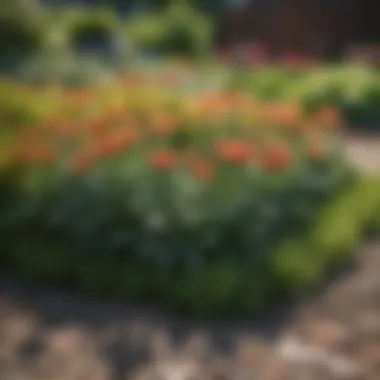

Using these natural methods allows homeowners to engage in effective weed management while promoting a healthy garden ecosystem. By opting for more environmentally friendly approaches, gardeners not only tackle weed problems but also contribute positively to their local environment.
Preventing Future Growth
Preventing the growth of grass and weeds in flower beds is critical for maintaining the health and beauty of your garden. Once weeds establish themselves, they can quickly overpower your flower plants, competing for essential resources like sunlight, nutrients, and water. This section delves into a few specific strategies that can help avoid future weed issues while promoting a thriving growth environment for desired flowers.
Choosing the Right Plants
Selecting the appropriate plants for your flower beds can significantly reduce weed problems. Native plants or flowers that are well adapted to your local climate tend to thrive more. They often require less maintenance and are more resistant to pests and diseases. Additionally, consider selecting plants with dense foliage; these can create a natural barrier that limits light penetration, thus inhibiting weed germination.
Here are some key considerations for plant selection:
- Opt for perennial plants that return each year, reducing the need for replanting.
- Choose plants with expansive root systems to outcompete weeds for nutrients.
- Look at ground cover plants that can fill in spaces, minimizing the opportunity for weeds to grow.
By making informed choices about plant selection, your flower beds will be less prone to invasion from unwanted grasses and weeds.
Designing Flower Beds for Success
A well-thought-out design of your flower beds can prevent future growth of grass and weeds. Proper spacing between plants is vital. Overcrowded areas can promote damp conditions that weeds enjoy. Implementing layers or zones in your flower beds, with taller plants in the back and shorter ones in the front, can improve light distribution and air circulation, which reduces moisture that could encourage weed growth.
Other design factors include:
- Pathways: Establishing clear pathways can limit foot traffic over flower beds, helping to prevent soil compaction that encourages weed growth.
- Borders: Using materials such as stones, bricks, or plastic edging can help define the area and act as a barrier against encroaching weeds.
- Soil Preparation: Ensure your soil has proper drainage and nutrients. Poorly nourished soil can weaken plants, making them more susceptible to weeds.
Investing in a thoughtful design will set up a flower bed for long-term success.
Regular Maintenance Practices
To sustain weed control in flower beds, regular maintenance is essential. Consistent activities such as mulching, hoeing, and monitoring plant health will play a significant role in preventing future growth. Schedule at least seasonal walks through the garden to identify emerging weeds before they become problematic.
Here are practical maintenance practices:
- Mulching: Apply mulch around plants to suppress weeds by blocking sunlight while maintaining soil moisture.
- Soil Testing: Conduct soil tests to maintain optimal nutrient levels, which helps flowers grow robust and competitive against weeds.
- Pruning and Deadheading: Regularly remove dead plant material. This can eliminate potential habitats for weed seeds and improve the overall appearance of your flower beds.
Regular maintenance is the backbone of an effective garden management strategy that prevents the resurgence of weeds.
Closure
The conclusion serves as a pivotal element in this article by synthesizing the critical information presented throughout. When dealing with the challenges of grass and weeds in flower beds, it is essential to recognize the importance of employing effective strategies tailored to individual garden needs.
Understanding various methods—be it manual techniques, chemical solutions, or natural approaches—enables gardeners to select the most appropriate tactics based on their specific circumstances. Each method has its own set of benefits and drawbacks, thus, careful consideration is vital to ensure long-lasting results and minimal harm to the surrounding ecosystem.
Summary of Effective Strategies
In summary, combining different methods can yield optimal results in the battle against unwanted greenery. Here are key strategies based on the article's discussions:
- Manual Removal: Regular hand-pulling, using the right tools, and following best practices help keep weeds at bay.
- Chemical Solutions: Utilizing herbicides should be approached cautiously. Knowledge about the types and resistance is fundamental to effective application.
- Natural Methods: Employing techniques such as mulching, using boiling water, or vinegar can effectively control weed growth without harming plants.
- Preventive Measures: Plant selection and regular maintenance form the cornerstone of a weed-resistant flower bed.
By employing these strategies, homeowners can significantly improve the health and visual appeal of their flower beds. Incorporating best practices into routine maintenance is the surest way to enjoy flourishing gardens.
The Ongoing Battle Against Weeds
The fight against weeds is indeed an ongoing endeavor. Weeds are resilient, and new ones can emerge despite diligent efforts. Therefore, continuous monitoring and timely intervention are crucial. Keeping up with maintenance practices will not only manage the current weed population but also prevent future ones from taking root.
Gardening aficionados should regularly evaluate their flower beds and adapt strategies as necessary. Observing trends and changes in weed types can provide clues about what methods are most effective. Ultimately, embracing a proactive stance in garden management fosters a robust environment, allowing your flowers to thrive while minimizing the impact of invasive grass and weeds.















